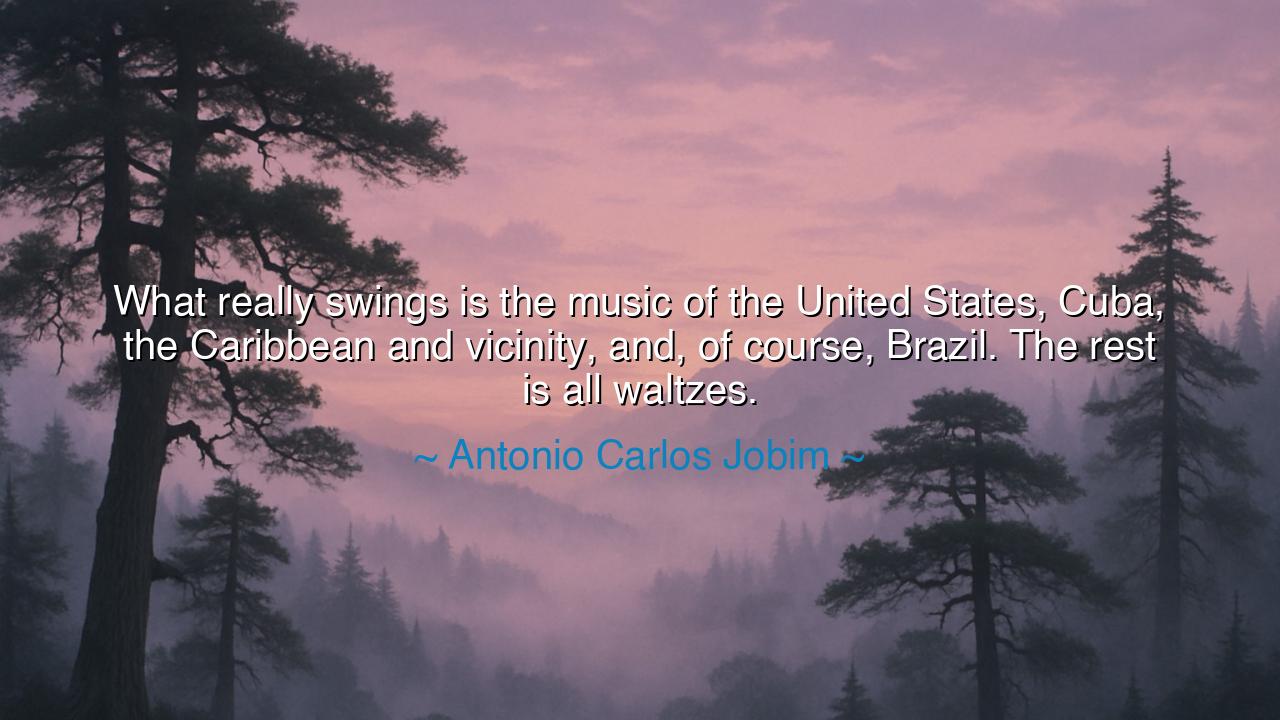
What really swings is the music of the United States, Cuba, the
What really swings is the music of the United States, Cuba, the Caribbean and vicinity, and, of course, Brazil. The rest is all waltzes.






The master of bossa nova, Antonio Carlos Jobim, once said with the elegance of a sage: “What really swings is the music of the United States, Cuba, the Caribbean and vicinity, and, of course, Brazil. The rest is all waltzes.” In this bold proclamation, Jobim points to the living pulse of music—the rhythms that move not only the body, but the soul. For he tells us that the true swing, the music of life itself, is born in lands where history, struggle, joy, and sorrow meet in sound. In contrast, the stately waltz, though beautiful, represents formality, restraint, and order. Jobim honors not what is rigid, but what is alive.
The ancients too would have recognized this distinction. Plato spoke of modes and harmonies that could stir courage or lull the spirit into passivity. What Jobim calls swing is this stirring force: syncopation, improvisation, rhythm born from community and struggle. It is the heartbeat of jazz, the dance of samba, the fire of rumba, the soul of calypso. These are not songs meant only to please the ear; they are living expressions of people who have sung through hardship and rejoiced through rhythm. They carry the essence of survival and celebration, a vibrancy that cannot be contained by rigid form.
Consider the birth of jazz in the United States. It arose from African traditions mingling with European instruments, forged in the crucible of slavery, poverty, and resilience. It was raw, it was improvised, it swung with a rhythm that spoke of sorrow transformed into joy. Similarly, in Cuba and the Caribbean, music blended African drums with Spanish guitars, birthing salsa, son, and reggae. In Brazil, Jobim himself wove samba and jazz into bossa nova, a music that seemed as gentle as the ocean yet carried the heartbeat of a nation. These were not polished waltzes—they were the swing of life itself.
History shows us that the world has often elevated the orderly and restrained—court dances, aristocratic forms, and polished compositions. Yet time and again, the music of the people, the swing of the streets, has endured. The waltz may have filled palaces, but samba filled the favelas, jazz filled Harlem, son filled Havana. And it is these that spread across the world, inspiring generation after generation. Jobim’s words remind us that what truly lasts is not the rigid beauty of formality, but the wild, beating heart of rhythm.
The deeper wisdom here is about life itself. To live only in waltzes is to live with too much restraint, too much formality, too much concern for appearances. To live with swing is to embrace unpredictability, to celebrate improvisation, to dance with both joy and pain. The music of the Americas and the Caribbean embodies this: it was born not in ease, but in resilience, in communities that transformed suffering into sound. In this way, Jobim’s words are more than about music—they are about how to live fully.
The lesson for us is this: seek the swing in your own life. Do not become trapped only in order, in rigid structure, in walking the same measured steps. Allow yourself to improvise, to move to rhythms not written down, to embrace the richness of spontaneity. Just as jazz musicians listen and respond in the moment, so too should we listen deeply to life and respond with creativity and courage. The waltz has its beauty, but it is the swing that awakens the soul.
Practically, this means surrounding yourself with the rhythms of life—listen to the music of different cultures, learn the dances of the people, let yourself be moved not only by order but by passion. In your work, in your relationships, leave space for improvisation, for joy, for risk. Remember that the greatest art of the Americas was born not of perfection, but of swing—the courage to create in the midst of uncertainty.
Thus, let Jobim’s words endure: what really swings is the music born of rhythm, struggle, and joy. It is the music of the Americas, the Caribbean, Brazil—it is the music of life itself. The rest may be waltzes, beautiful but restrained. Choose to live in swing, to let your life carry rhythm and fire, and you will discover a melody that outlasts the ages.






AAdministratorAdministrator
Welcome, honored guests. Please leave a comment, we will respond soon